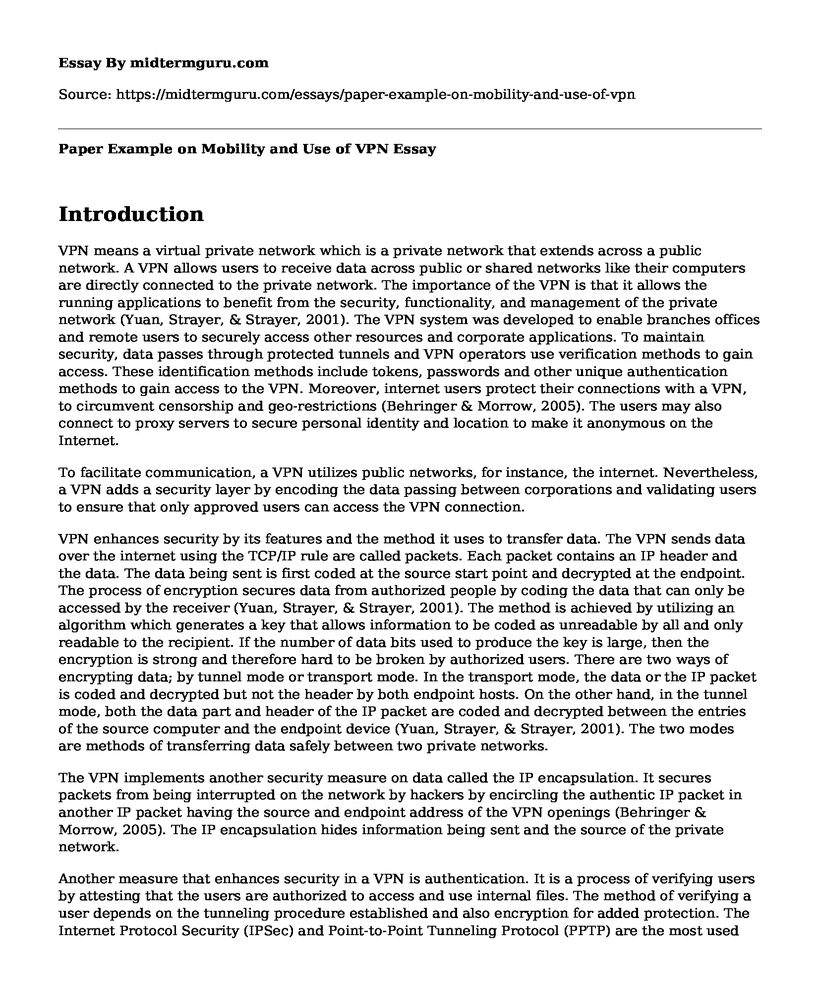Introduction
VPN means a virtual private network which is a private network that extends across a public network. A VPN allows users to receive data across public or shared networks like their computers are directly connected to the private network. The importance of the VPN is that it allows the running applications to benefit from the security, functionality, and management of the private network (Yuan, Strayer, & Strayer, 2001). The VPN system was developed to enable branches offices and remote users to securely access other resources and corporate applications. To maintain security, data passes through protected tunnels and VPN operators use verification methods to gain access. These identification methods include tokens, passwords and other unique authentication methods to gain access to the VPN. Moreover, internet users protect their connections with a VPN, to circumvent censorship and geo-restrictions (Behringer & Morrow, 2005). The users may also connect to proxy servers to secure personal identity and location to make it anonymous on the Internet.
To facilitate communication, a VPN utilizes public networks, for instance, the internet. Nevertheless, a VPN adds a security layer by encoding the data passing between corporations and validating users to ensure that only approved users can access the VPN connection.
VPN enhances security by its features and the method it uses to transfer data. The VPN sends data over the internet using the TCP/IP rule are called packets. Each packet contains an IP header and the data. The data being sent is first coded at the source start point and decrypted at the endpoint. The process of encryption secures data from authorized people by coding the data that can only be accessed by the receiver (Yuan, Strayer, & Strayer, 2001). The method is achieved by utilizing an algorithm which generates a key that allows information to be coded as unreadable by all and only readable to the recipient. If the number of data bits used to produce the key is large, then the encryption is strong and therefore hard to be broken by authorized users. There are two ways of encrypting data; by tunnel mode or transport mode. In the transport mode, the data or the IP packet is coded and decrypted but not the header by both endpoint hosts. On the other hand, in the tunnel mode, both the data part and header of the IP packet are coded and decrypted between the entries of the source computer and the endpoint device (Yuan, Strayer, & Strayer, 2001). The two modes are methods of transferring data safely between two private networks.
The VPN implements another security measure on data called the IP encapsulation. It secures packets from being interrupted on the network by hackers by encircling the authentic IP packet in another IP packet having the source and endpoint address of the VPN openings (Behringer & Morrow, 2005). The IP encapsulation hides information being sent and the source of the private network.
Another measure that enhances security in a VPN is authentication. It is a process of verifying users by attesting that the users are authorized to access and use internal files. The method of verifying a user depends on the tunneling procedure established and also encryption for added protection. The Internet Protocol Security (IPSec) and Point-to-Point Tunneling Protocol (PPTP) are the most used protocols for verification over the internet. The internet that uses the VPN develops a Security Association (SA) and verifies users by switching keys which are produced by an algorithm (Behringer & Morrow, 2005).
Conclusion
In conclusion, the strength on the internet is growing rapidly which may challenge the privacy in the process of transferring. A VPN meets the companies' needs to improve security and also reliability. VPN enhances security through its features and the method it utilizes to transfer data. The VPN sends data over the internet using the TCP/IP rule are called packets. Each packet contains an IP header and the data. IP encapsulation is another security measure which protects the packets from being interrupted on the network by hackers by encircling the authentic IP packet in another IP packet having the source and endpoint address of the VPN openings. User authorization is the last security measure that VPN adopts to ensure that only authorized access the data.
References
Yuan, R., Strayer, W. T., & Strayer, T. (2001). Virtual private networks: technologies and solutions. Addison-Wesley.
Behringer, M. H., & Morrow, M. (2005). Mpls VPN Security. Cisco Press
Cite this page
Paper Example on Mobility and Use of VPN. (2022, Aug 29). Retrieved from https://midtermguru.com/essays/paper-example-on-mobility-and-use-of-vpn
If you are the original author of this essay and no longer wish to have it published on the midtermguru.com website, please click below to request its removal:
- Research Paper on Key Issues in Cyber Policy
- The Awareness of Password in Organization for Security Purpose: Research Proposal
- Microsoft Access: Unlocking the Power of Database Management for John - Essay Sample
- Haiti Earthquake 2010 - Essay Sample
- Internet: Blessing or Curse? The Debate Rages On - Essay Sample
- Internet: From Origin to Global Society Impact - Essay Sample
- Department Store Increases Sales With New Database System - Essay Sample







